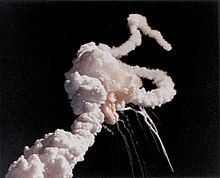STS-51-L
It was planned as the first Teacher in Space Project flight in addition to observing Halley's Comet for six days and performing a routine satellite deployment.
The mission never achieved orbit; a structural failure during its ascent phase 73 seconds after launch from Kennedy Space Center Launch Complex 39B on January 28, 1986, destroyed the orbiter and killed all seven crew members—Commander Francis R. "Dick" Scobee, Pilot Michael J. Smith, Mission Specialists Ellison S. Onizuka, Judith A. Resnik and Ronald E. McNair, and Payload Specialists Gregory B. Jarvis and S. Christa McAuliffe.
The tenth mission for Challenger, STS-51-L, was scheduled to deploy the second in a series of Tracking and Data Relay Satellites (TDRS-B), carry out the first flight of the "Shuttle Pointed Autonomous Research Tool for Astronomy" (SPARTAN-203) / Halley's Comet Experiment Deployable in order to observe Halley's Comet, and carry out several lessons from space as part of the Teacher in Space Project and Shuttle Student Involvement Program (SSIP).
The Rogers Commission later determined the cause of the accident to have been the failure of the primary and secondary (backup) O-ring seals on Challenger's right Solid Rocket Booster (SRB).
[8] No official investigation into the Challenger disaster has determined the cause of death of the astronauts; it is almost certain that the breakup itself did not kill the entire crew as 3 of the 4 Personal Egress Air Packs (PEAPs) that were recovered had been manually activated.
[9] There were media reports alleging that NASA had a tape recording of the crew panicking and on-board conversation following the explosion during the 2 minute 45 second free fall before hitting the sea east of Florida.
